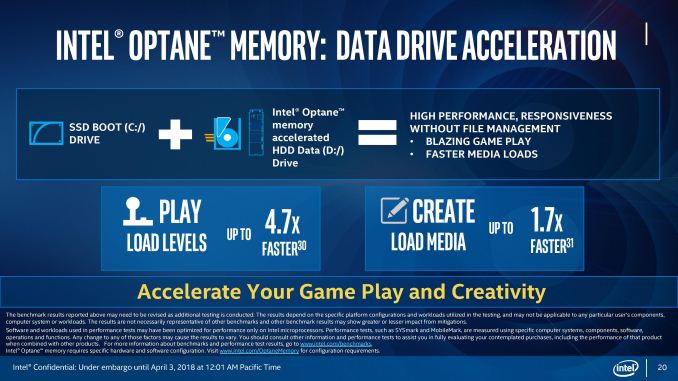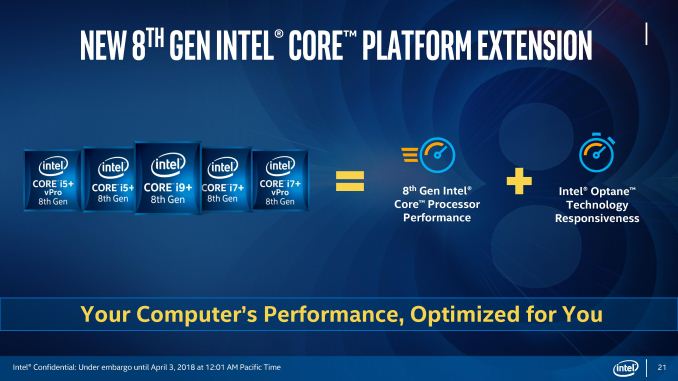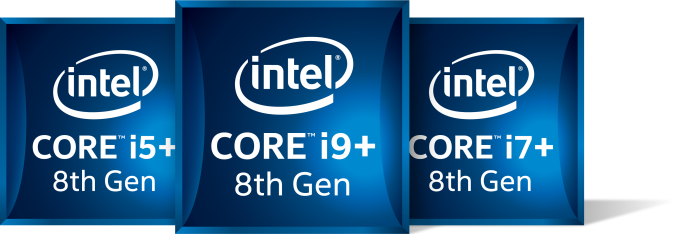Intel Expands 8th Gen Core: Core i9 on Mobile, Iris Plus, Desktop, Chipsets, and vPro
by Ian Cutress on April 3, 2018 3:01 AM ESTNew Optane Branding
Core i9+, Core i7+, Core i5+
One of the items that Intel is keen to promote with this launch is an update to its Intel RST algorithm when dealing with ‘Optane Memory’, Intel’s brand for Optane whereby a small amount of storage is placed in front of a larger drive to act as a fast cache. Up to this point, Intel platforms that supported Optane Memory in this configuration could only do so on the drive that was used to boot into the operating system. While this worked well for low-cost users that relied on a single rotational hard-disk drive of rust for their needs, with most enthusiasts using a fast SSD (SATA or PCIe) as their first drive that loads the OS, putting Optane Memory in front of this as a cache was relatively pointless – any gains would be intangible at best. With the new generation of products, Intel has expanded the capabilities of Optane Memory such that it can act as a cache for a non-OS drive. This means that a user can have a fast SSD boot drive, a large spinning drive for storage, and then place Optane in front of that storage drive to potentially get much better performance from the drive.
The main idea here is that the large rotational drive is where users store games and large files used in content creation, which often have a long loading time. With the right caching algorithm, and a decent sized Optane Memory drive, Intel likes to promote that loading games and loading media for creative purposes are several factors faster than an equivalent system without an Optane Memory drive.
Part of the news around Optane is that Intel is now creating new processor branding for OEMs that have configurations with Optane. The new brands and logos are similar to the standard Core i5/i7 style that we are used to, however the logos are now a dark blue with white text, and exhibit a plus after the Core i5/i7 name.
So just to be clear, this is not a new line of processors. We will not have to suddenly deal with a Core i9+-8950HK being different to the non-plus counterpart. This is purely a branding exercise, and one that only covers the i5 and higher at that. However, to complicate things, this means that specification sheets can (and will) list the processors as Core i5+ and Core i7+ and even vPro models. This makes looking for particular processor versions in search engines a lot more difficult for almost no obvious benefit. I mean sure, Intel wants to promote the use of its Optane drives, but we already have the Optane branding and the Optane logos to do that for us. This ends up being another logo put onto the box.
Ultimately, Intel is still marketing Optane, its high-cost R&D product, with low capacities at low cost systems with relatively little margin. While it might seem like a noble goal, to bring extra caching performance down to the lower cost segment, it could very easily be done with SATA or PCIe M.2 drives using regular NAND flash. A lot of users would like to see high-capacity, high-endurance Optane drives moving more into the mainstream, instead of more attempts at funneling in a product like Optane into caching.













123 Comments
View All Comments
wr3zzz - Tuesday, April 3, 2018 - link
What is the target market for the new T-series chips? It's the same price as the chip with iGPU and the lower TDP comes at the cost of lower clock and still no overclocking.A5 - Tuesday, April 3, 2018 - link
OEM SFF boxes, like the Dell Optiplex Micro series.xrror - Tuesday, April 3, 2018 - link
i9. Mobile. 6 core with no HT.Intel ... the i9 branding already is a tortured SKU name. Anything i9 should be auto-badass awesome insaneballs SKU.
Instead, we get the insult that i9 is not only brought back for ANY SKU, but a mobile SKU. Which is already lying BS marketing SKU (hey, a mobile i7 is actually 2 real cores + HT which in desktop land is a low end i3 but who cares! marketing!).
While a mobile coffee lake native 6 core with no HT WOULD have been impressive (assuming no tard low base speed) as a very high i5 or i7 mobile... resurrecting the tortured i9 branding with anything less than 12 cores (of any dam*** sort) is insulting.
FU intel. And FU to all the folks who gobble this up at a premium cause 9 > 7 in mobile land which enables Intel Marketing to justify this ****
xrror - Tuesday, April 3, 2018 - link
I just have to add, the cynicism in this article from Ian is amazing. That's no insult or judgement - just "holy moly, it's so bad even finally it broke through."I don't want to face the reality that PC hardware doesn't mean anything to the average (mass market - quantity) buyer when purchasing their next disposable facebook terminal....
I don't. .. . .. ... .. *cry*
close - Wednesday, April 4, 2018 - link
It's so bad even AT is kicking Intel to the curb :).satai - Tuesday, April 3, 2018 - link
iX does make sense only inside a segment. You can't suppose, that i7 for ultrabooks is comparable to i7 fo HEDT. This is not a technical term, it's marketing term. If you expect anything else...A5 - Tuesday, April 3, 2018 - link
...yeah. Getting *this* upset about a company's branding strategy is nuts.xrror - Tuesday, April 3, 2018 - link
fine, i guess I was nuts back when they did this with Sandy Bridge mobile. I'll consider myself chastised and STFU as you wish.Ratman6161 - Tuesday, April 3, 2018 - link
It bothers me because I'm involved in purchasing PC's for the company. Users always complaining because they bought the marketing and think what we are getting them is crap because it doesn't have an i7 sticker on it.PeachNCream - Tuesday, April 3, 2018 - link
Tell them they need to be more productive and waste less time so the company is more profitable an can afford to purchase i7 laptops.